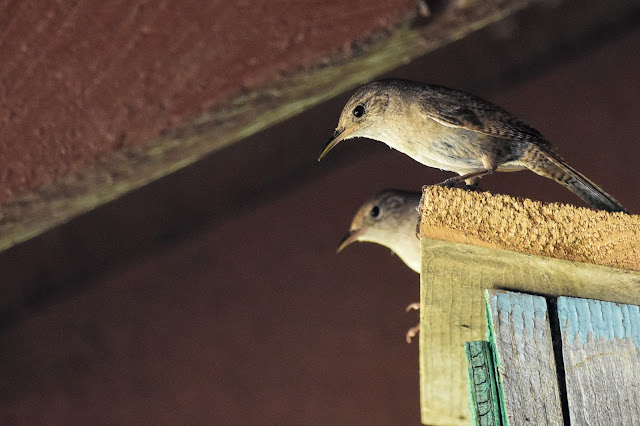There are three birds that occur in my area whose common names feature “house” as a descriptor: House Sparrow, House Finch, and House Wren.
In my experience, the distribution of these three “house birds” seems to follow the pattern of population density. House Sparrow is an introduced species from Europe, and like humans who immigrated to the New World, it has adapted well to life in towns and cities. As urban concentration of houses thins out toward the suburbs, House Sparrows are gradually replaced by House Finches. As to House Wrens, they don’t come into view until we reach the rural country.
That last point may not be true in other regions. A friend who lived in Missouri told me that House Wren would nest anywhere, even under your car if you didn’t drive the car for a day. I’ve never experienced such abundance of House Wren. My single encounter of a House Wren near any house happened just this year on a trip to Sierra Valley. At the “ranch” where we stayed, a family of House Wrens occupied a bird house under the eaves of a cabin.
House Wrens (Troglodytes aedon) apparently take up different ecologic niche from place to place in their vast range over North and South Americas. In my neck of the woods, I associate them with dry parklands where their preferred habitats are fallen logs and low shrubs that dot the open grassland. The most common wren in my neighborhood, however, is Bewick’s Wren (Thryomanes bewickii). It is vocal and feisty, and lives happily in backyards. It could well be our “house” wren if the name had not been taken.
I am surprised to find that among the 88 wrens in the family Troglodytidae, only one lives in the Old World. This lone Eurasian Wren (Troglodytes troglodytes) is the “house” wren to people who live in its range. Charles Darwin referred to it in his diary by a term of endearment: Kitty Wren (Charles Darwin's Life with Birds: His Complete Ornithology, Clifford B. Frith, 2016). Yet its closest resemblance on this side of the planet is not House Wren, but Pacific Wren and Winter Wren. In the past, Winter Wren (T. hiemalis), Pacific Wren (T. pacificus) and Eurasian Wren were thought to be the same species. They look awfully similar. Even their songs are tough to distinguish.
But in terms of the intimacy people feel with wrens, Eurasian Wren is likely of the same rank as House Wren, leaving Pacific Wren and Winter Wren in the dust. And the ease with which the European bird nests around people bears an uncanny similarity to the American bird. John James Audubon painted House Wrens nesting in a hat, while Eurasian Wrens are known to build their nests in coat pockets .
For close observations of House Wren, I defer to those who have the bird living by their house. Here is a wonderful example from Iowa.
In my experience, the distribution of these three “house birds” seems to follow the pattern of population density. House Sparrow is an introduced species from Europe, and like humans who immigrated to the New World, it has adapted well to life in towns and cities. As urban concentration of houses thins out toward the suburbs, House Sparrows are gradually replaced by House Finches. As to House Wrens, they don’t come into view until we reach the rural country.
That last point may not be true in other regions. A friend who lived in Missouri told me that House Wren would nest anywhere, even under your car if you didn’t drive the car for a day. I’ve never experienced such abundance of House Wren. My single encounter of a House Wren near any house happened just this year on a trip to Sierra Valley. At the “ranch” where we stayed, a family of House Wrens occupied a bird house under the eaves of a cabin.
 |
| Sierraville, June 2017. By Minder Cheng. |
House Wrens (Troglodytes aedon) apparently take up different ecologic niche from place to place in their vast range over North and South Americas. In my neck of the woods, I associate them with dry parklands where their preferred habitats are fallen logs and low shrubs that dot the open grassland. The most common wren in my neighborhood, however, is Bewick’s Wren (Thryomanes bewickii). It is vocal and feisty, and lives happily in backyards. It could well be our “house” wren if the name had not been taken.
I am surprised to find that among the 88 wrens in the family Troglodytidae, only one lives in the Old World. This lone Eurasian Wren (Troglodytes troglodytes) is the “house” wren to people who live in its range. Charles Darwin referred to it in his diary by a term of endearment: Kitty Wren (Charles Darwin's Life with Birds: His Complete Ornithology, Clifford B. Frith, 2016). Yet its closest resemblance on this side of the planet is not House Wren, but Pacific Wren and Winter Wren. In the past, Winter Wren (T. hiemalis), Pacific Wren (T. pacificus) and Eurasian Wren were thought to be the same species. They look awfully similar. Even their songs are tough to distinguish.
But in terms of the intimacy people feel with wrens, Eurasian Wren is likely of the same rank as House Wren, leaving Pacific Wren and Winter Wren in the dust. And the ease with which the European bird nests around people bears an uncanny similarity to the American bird. John James Audubon painted House Wrens nesting in a hat, while Eurasian Wrens are known to build their nests in coat pockets .
For close observations of House Wren, I defer to those who have the bird living by their house. Here is a wonderful example from Iowa.
 |
| House Wren at Donner Canyon, Mount Diablo State Park. May 2017. By Minder Cheng. |
Comments
Post a Comment